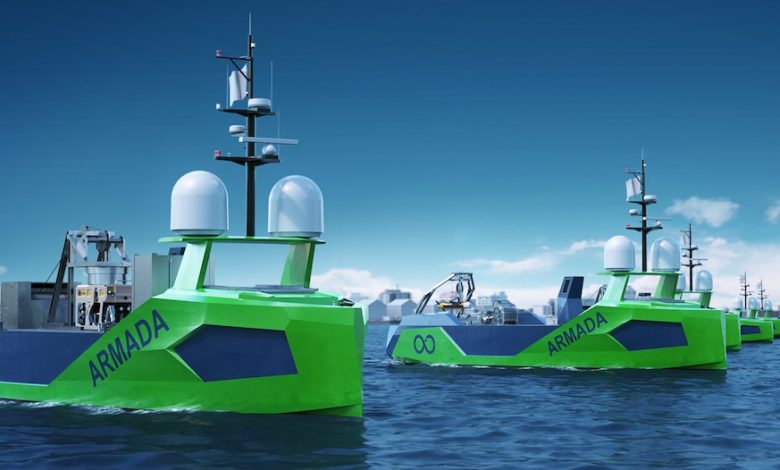Autonomous ships: Coming soon to a port near you

‘This sort of thing has cropped up before, and it has always been due to human error’ – Hal 9000, 2001, A Space Odyssey.
Russell Hodge from surveyors Pirie & Smith assesses where we are in the autonomous shipping drive and the rules and regulations that still need to be amended.
Ocean Infinity’s announcement that it will construct eight large (78 m long) autonomous ships brings the concept of large automated, remote controlled vessels suddenly closer. It would be fair to suggest that some of us had assumed that a gradual procession of tests and trials on different types of vessel would prove the concepts and reliability and permit the leading classification societies time to digest the technology and its implications. By announcing the decision to forge ahead and engage Vard to develop this series of vessels, Ocean Infinity has blown this approach out of the water.
Fugro have long considered themselves among the leaders of high-tech survey. Yet in January Ocean Infinity announced their Armada USV initiative with the unveiling, at the British Science Museum, of a fifteen-vessel robotic fleet ranging in size from 20 to 37 m.
By March Fugro announced its response: a partnership with Sea-Kit for a range of USVs of up to 24 m in length. Baird Maritime’s Hieronymus Bosch commented in April that this was Mark Heine throwing down the gauntlet at Ocean Infinity. This new announcement from Ocean Infinity could be seen as Oliver Plunkett’s right hook riposte in the challenge for world dominance in the subsea survey market.
Who is responsible if the autonomous vessel runs aground, allides with another vessel, drilling rig or an offshore storage facility?
Vessels of this size do not come cheap and this move marks a significant investment, at a guess well in the $100m range, for Ocean Infinity. Is this a do or die proposition for the company? I feel they will need to get it right first time as the commercial implications of failure will be significant.
Being the first in a field is not always a guarantee of success – consider Deep Ocean and its involvement in renewables.
As Ocean Infinity move forward at an accelerated pace, this may give Fugro the space to more carefully examine their own technological development in the same field. Will Fugro stand back and watch or take up the challenge? This is a difficult one to predict; Fugro is not exactly unfamiliar with exploring new technological boundaries, it is, after all what the company was built on.
In the meantime the International Maritime Organization and the classification societies will have to buckle down and start to pay real attention to developing practical rules. While some movement has been made (Class NK., the chosen lead society, issued its first set of autonomous ship rules in January of this year) there remain many issues still unresolved. Cyber security and redundancy remain principal issues to overcome in the practical sense, but the issues of salvage will still loom strongly in the event of control failure.
Fall back may, in a technical sense, be acceptable to fully autonomous control in communication failure, but how does a vessel under its own control stand legally from a salvage or liability point of view?
How does a vessel seek to return to remote control and who is responsible for its actions during the period that it is seeking return to remote command?
Not only do the control algorithms need development but the legal / insurance liabilities require clarification. There has been some discussion on the matter, along which is the remarkable discovery that there is no fixed definition on what actually counts as a ship or vessel and some interpretations of SOLAS would seem to preclude fully automated vessels. COLREGS too requires human judgment in the decision-making loop which is not possible in a fully autonomous vessel and the provision for total autonomy must be made in the control system for total failure of the communication system on vessels which are remotely controlled.
Who is responsible if the autonomous vessel runs aground, allides with another vessel, drilling rig or an offshore storage facility? Generally, liability is dependent upon the determination of who was at fault in the incident under consideration. Under the Convention for the Unification of Certain Rules of Law with respect to Collisions between Vessels, 1910, the proportion of liability is based upon the determination of the level of fault on the part of the respective vessels – can we blame a computer or does the fault, and liability, lie with the programmer ? Now, that would be a very interesting loophole to explore.
The major classification societies have issued provisional or proposed guidelines for autonomous ships though class notations at this time remain largely absent, and approaches, even under the IACS banner, differ to some extent. A review of the published guidelines and their approaches to verification and compliance may be the subject of a future article.
While a lot has been written, and ships (if, indeed, they are ships) are being built there remain gaps to be plugged. It is all food for thought.

The definition of a vessel is very clear. It is laid out in the “International Regulations for Preventing Collisions at Sea” Rule 3 part (a)